Gore-Tex Case Study: Innovation, Strategy, and Challenges in Market
VerifiedAdded on 2022/10/03
|6
|1723
|353
Case Study
AI Summary
This case study analyzes W.L. Gore & Associates (Gore-Tex), focusing on its innovation process, organizational structure, and market strategies. The analysis utilizes the Cyclic Innovation Model to illustrate Gore-Tex's innovation journey, emphasizing the company's reliance on technological advancements and its unique organizational culture. The study also explores the potential dangers of being overly technology-focused, such as the risk of cyber-attacks and loss of intellectual property. Furthermore, it examines Gore-Tex's success in the market, achieved through direct marketing and product innovation, and discusses the challenges the company faces from emerging competitors. The report highlights the importance of adaptability and the need for Gore-Tex to maintain its competitive edge through continued product development and customer loyalty to sustain its market position. The assignment includes references to support the arguments made in the case study analysis.
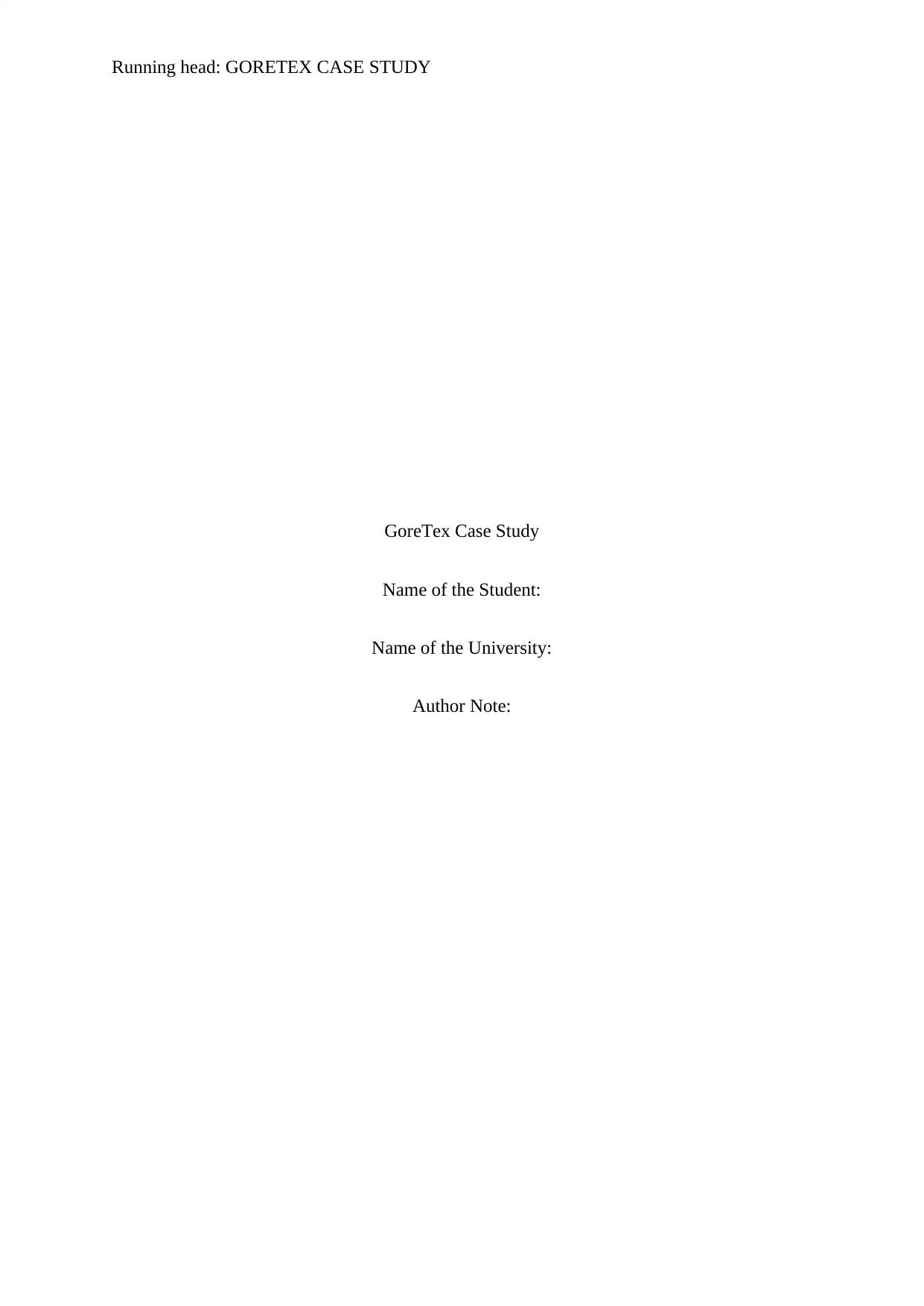
Running head: GORETEX CASE STUDY
GoreTex Case Study
Name of the Student:
Name of the University:
Author Note:
GoreTex Case Study
Name of the Student:
Name of the University:
Author Note:
Paraphrase This Document
Need a fresh take? Get an instant paraphrase of this document with our AI Paraphraser
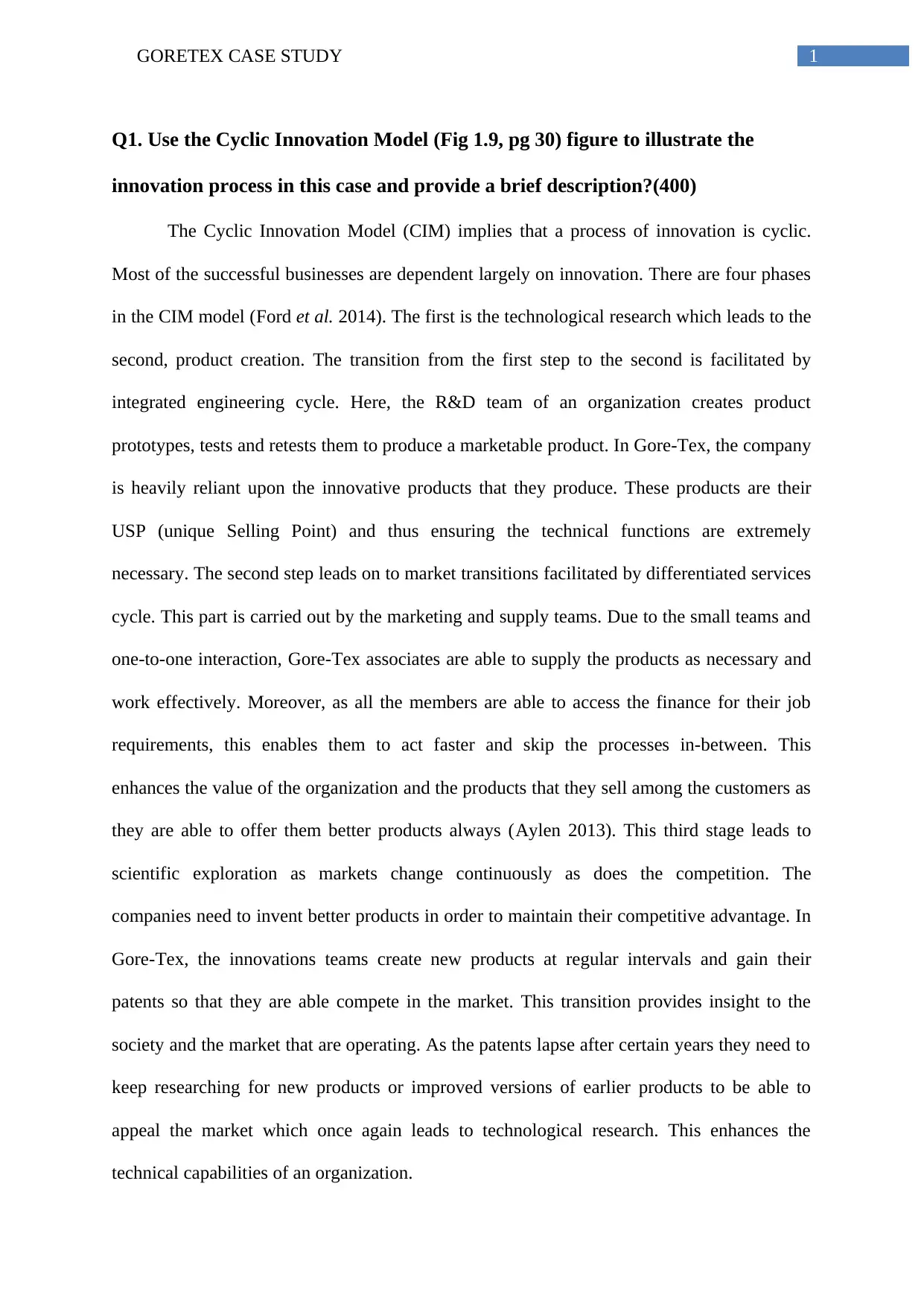
1GORETEX CASE STUDY
Q1. Use the Cyclic Innovation Model (Fig 1.9, pg 30) figure to illustrate the
innovation process in this case and provide a brief description?(400)
The Cyclic Innovation Model (CIM) implies that a process of innovation is cyclic.
Most of the successful businesses are dependent largely on innovation. There are four phases
in the CIM model (Ford et al. 2014). The first is the technological research which leads to the
second, product creation. The transition from the first step to the second is facilitated by
integrated engineering cycle. Here, the R&D team of an organization creates product
prototypes, tests and retests them to produce a marketable product. In Gore-Tex, the company
is heavily reliant upon the innovative products that they produce. These products are their
USP (unique Selling Point) and thus ensuring the technical functions are extremely
necessary. The second step leads on to market transitions facilitated by differentiated services
cycle. This part is carried out by the marketing and supply teams. Due to the small teams and
one-to-one interaction, Gore-Tex associates are able to supply the products as necessary and
work effectively. Moreover, as all the members are able to access the finance for their job
requirements, this enables them to act faster and skip the processes in-between. This
enhances the value of the organization and the products that they sell among the customers as
they are able to offer them better products always (Aylen 2013). This third stage leads to
scientific exploration as markets change continuously as does the competition. The
companies need to invent better products in order to maintain their competitive advantage. In
Gore-Tex, the innovations teams create new products at regular intervals and gain their
patents so that they are able compete in the market. This transition provides insight to the
society and the market that are operating. As the patents lapse after certain years they need to
keep researching for new products or improved versions of earlier products to be able to
appeal the market which once again leads to technological research. This enhances the
technical capabilities of an organization.
Q1. Use the Cyclic Innovation Model (Fig 1.9, pg 30) figure to illustrate the
innovation process in this case and provide a brief description?(400)
The Cyclic Innovation Model (CIM) implies that a process of innovation is cyclic.
Most of the successful businesses are dependent largely on innovation. There are four phases
in the CIM model (Ford et al. 2014). The first is the technological research which leads to the
second, product creation. The transition from the first step to the second is facilitated by
integrated engineering cycle. Here, the R&D team of an organization creates product
prototypes, tests and retests them to produce a marketable product. In Gore-Tex, the company
is heavily reliant upon the innovative products that they produce. These products are their
USP (unique Selling Point) and thus ensuring the technical functions are extremely
necessary. The second step leads on to market transitions facilitated by differentiated services
cycle. This part is carried out by the marketing and supply teams. Due to the small teams and
one-to-one interaction, Gore-Tex associates are able to supply the products as necessary and
work effectively. Moreover, as all the members are able to access the finance for their job
requirements, this enables them to act faster and skip the processes in-between. This
enhances the value of the organization and the products that they sell among the customers as
they are able to offer them better products always (Aylen 2013). This third stage leads to
scientific exploration as markets change continuously as does the competition. The
companies need to invent better products in order to maintain their competitive advantage. In
Gore-Tex, the innovations teams create new products at regular intervals and gain their
patents so that they are able compete in the market. This transition provides insight to the
society and the market that are operating. As the patents lapse after certain years they need to
keep researching for new products or improved versions of earlier products to be able to
appeal the market which once again leads to technological research. This enhances the
technical capabilities of an organization.
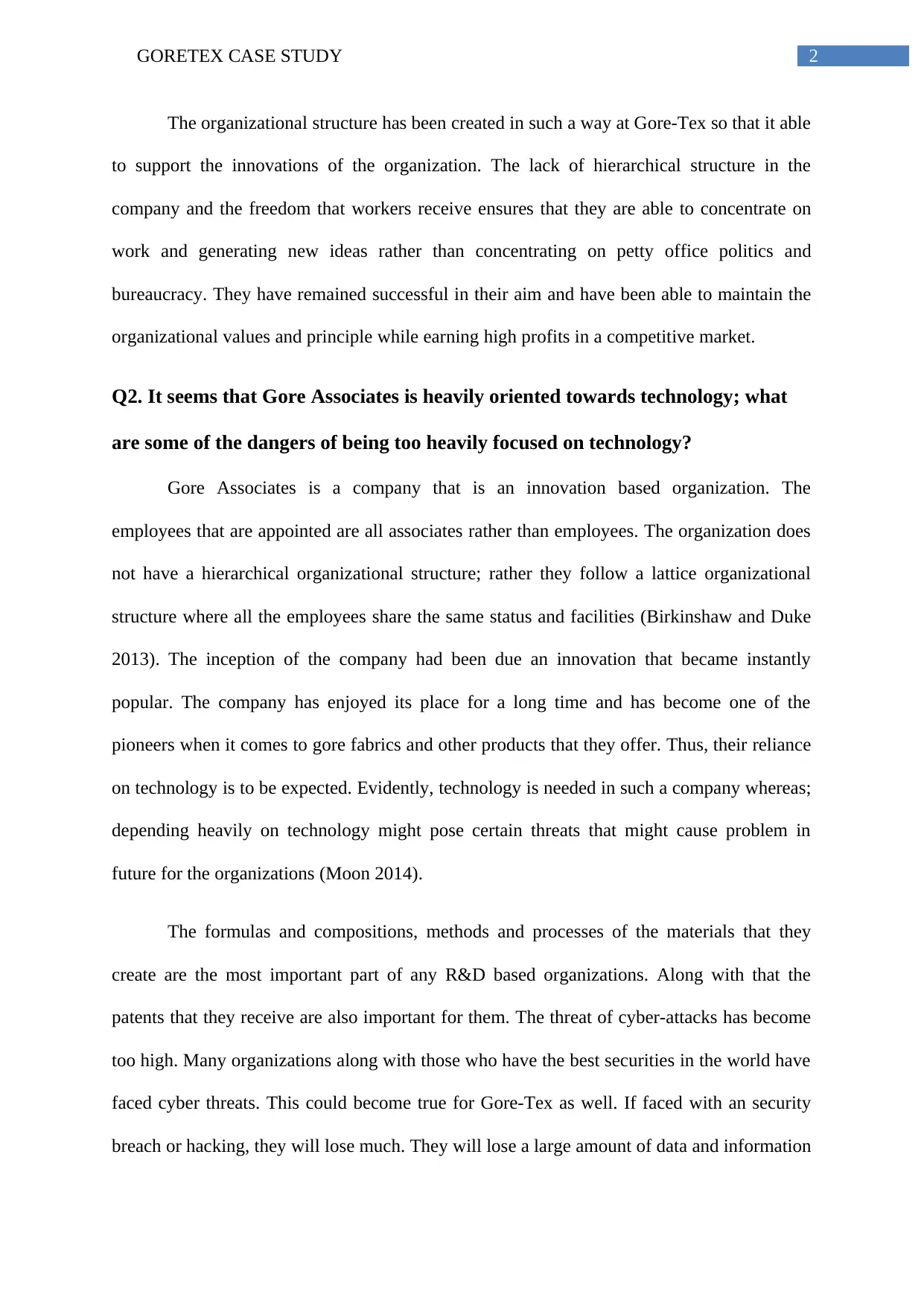
2GORETEX CASE STUDY
The organizational structure has been created in such a way at Gore-Tex so that it able
to support the innovations of the organization. The lack of hierarchical structure in the
company and the freedom that workers receive ensures that they are able to concentrate on
work and generating new ideas rather than concentrating on petty office politics and
bureaucracy. They have remained successful in their aim and have been able to maintain the
organizational values and principle while earning high profits in a competitive market.
Q2. It seems that Gore Associates is heavily oriented towards technology; what
are some of the dangers of being too heavily focused on technology?
Gore Associates is a company that is an innovation based organization. The
employees that are appointed are all associates rather than employees. The organization does
not have a hierarchical organizational structure; rather they follow a lattice organizational
structure where all the employees share the same status and facilities (Birkinshaw and Duke
2013). The inception of the company had been due an innovation that became instantly
popular. The company has enjoyed its place for a long time and has become one of the
pioneers when it comes to gore fabrics and other products that they offer. Thus, their reliance
on technology is to be expected. Evidently, technology is needed in such a company whereas;
depending heavily on technology might pose certain threats that might cause problem in
future for the organizations (Moon 2014).
The formulas and compositions, methods and processes of the materials that they
create are the most important part of any R&D based organizations. Along with that the
patents that they receive are also important for them. The threat of cyber-attacks has become
too high. Many organizations along with those who have the best securities in the world have
faced cyber threats. This could become true for Gore-Tex as well. If faced with an security
breach or hacking, they will lose much. They will lose a large amount of data and information
The organizational structure has been created in such a way at Gore-Tex so that it able
to support the innovations of the organization. The lack of hierarchical structure in the
company and the freedom that workers receive ensures that they are able to concentrate on
work and generating new ideas rather than concentrating on petty office politics and
bureaucracy. They have remained successful in their aim and have been able to maintain the
organizational values and principle while earning high profits in a competitive market.
Q2. It seems that Gore Associates is heavily oriented towards technology; what
are some of the dangers of being too heavily focused on technology?
Gore Associates is a company that is an innovation based organization. The
employees that are appointed are all associates rather than employees. The organization does
not have a hierarchical organizational structure; rather they follow a lattice organizational
structure where all the employees share the same status and facilities (Birkinshaw and Duke
2013). The inception of the company had been due an innovation that became instantly
popular. The company has enjoyed its place for a long time and has become one of the
pioneers when it comes to gore fabrics and other products that they offer. Thus, their reliance
on technology is to be expected. Evidently, technology is needed in such a company whereas;
depending heavily on technology might pose certain threats that might cause problem in
future for the organizations (Moon 2014).
The formulas and compositions, methods and processes of the materials that they
create are the most important part of any R&D based organizations. Along with that the
patents that they receive are also important for them. The threat of cyber-attacks has become
too high. Many organizations along with those who have the best securities in the world have
faced cyber threats. This could become true for Gore-Tex as well. If faced with an security
breach or hacking, they will lose much. They will lose a large amount of data and information
⊘ This is a preview!⊘
Do you want full access?
Subscribe today to unlock all pages.

Trusted by 1+ million students worldwide
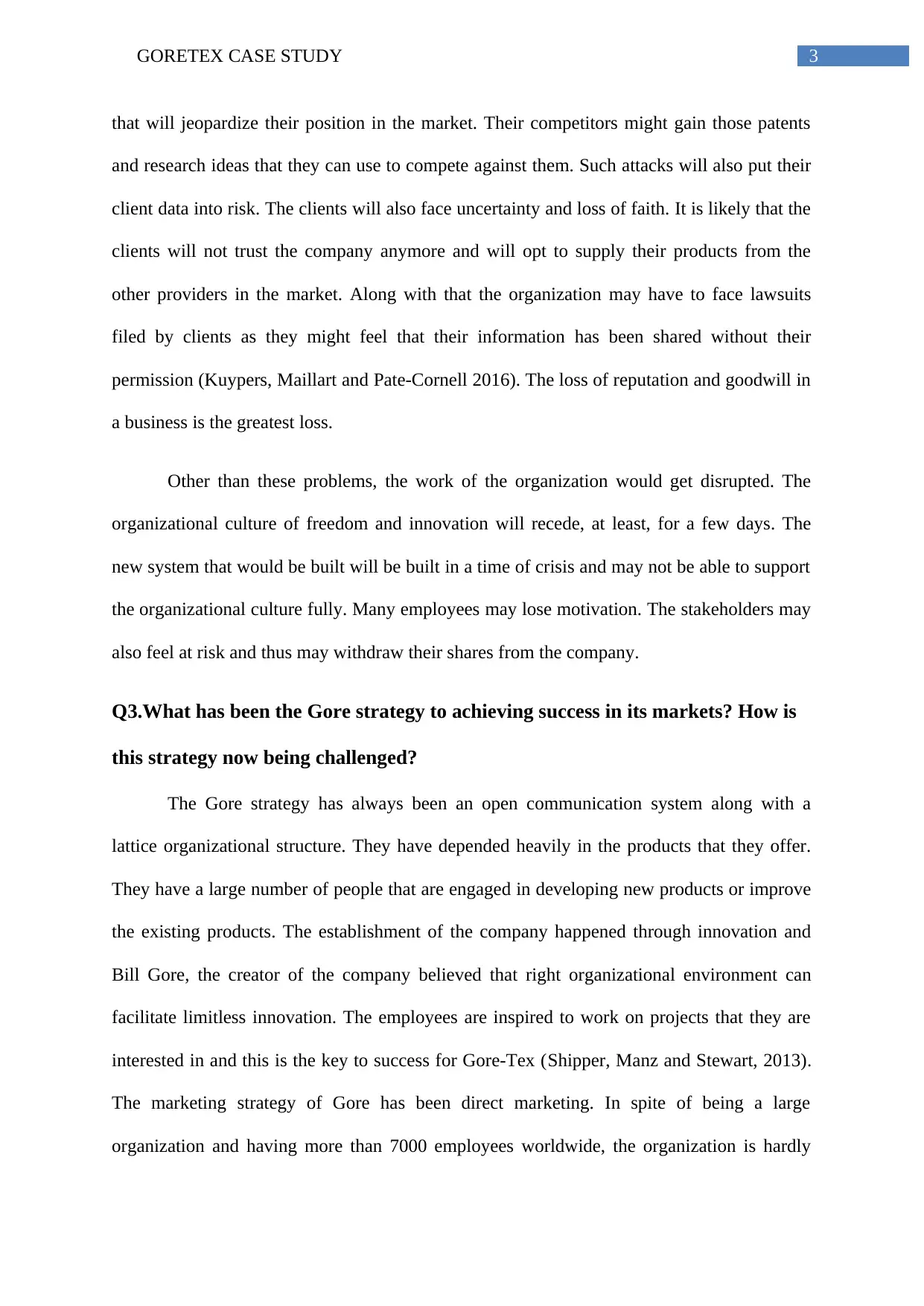
3GORETEX CASE STUDY
that will jeopardize their position in the market. Their competitors might gain those patents
and research ideas that they can use to compete against them. Such attacks will also put their
client data into risk. The clients will also face uncertainty and loss of faith. It is likely that the
clients will not trust the company anymore and will opt to supply their products from the
other providers in the market. Along with that the organization may have to face lawsuits
filed by clients as they might feel that their information has been shared without their
permission (Kuypers, Maillart and Pate-Cornell 2016). The loss of reputation and goodwill in
a business is the greatest loss.
Other than these problems, the work of the organization would get disrupted. The
organizational culture of freedom and innovation will recede, at least, for a few days. The
new system that would be built will be built in a time of crisis and may not be able to support
the organizational culture fully. Many employees may lose motivation. The stakeholders may
also feel at risk and thus may withdraw their shares from the company.
Q3.What has been the Gore strategy to achieving success in its markets? How is
this strategy now being challenged?
The Gore strategy has always been an open communication system along with a
lattice organizational structure. They have depended heavily in the products that they offer.
They have a large number of people that are engaged in developing new products or improve
the existing products. The establishment of the company happened through innovation and
Bill Gore, the creator of the company believed that right organizational environment can
facilitate limitless innovation. The employees are inspired to work on projects that they are
interested in and this is the key to success for Gore-Tex (Shipper, Manz and Stewart, 2013).
The marketing strategy of Gore has been direct marketing. In spite of being a large
organization and having more than 7000 employees worldwide, the organization is hardly
that will jeopardize their position in the market. Their competitors might gain those patents
and research ideas that they can use to compete against them. Such attacks will also put their
client data into risk. The clients will also face uncertainty and loss of faith. It is likely that the
clients will not trust the company anymore and will opt to supply their products from the
other providers in the market. Along with that the organization may have to face lawsuits
filed by clients as they might feel that their information has been shared without their
permission (Kuypers, Maillart and Pate-Cornell 2016). The loss of reputation and goodwill in
a business is the greatest loss.
Other than these problems, the work of the organization would get disrupted. The
organizational culture of freedom and innovation will recede, at least, for a few days. The
new system that would be built will be built in a time of crisis and may not be able to support
the organizational culture fully. Many employees may lose motivation. The stakeholders may
also feel at risk and thus may withdraw their shares from the company.
Q3.What has been the Gore strategy to achieving success in its markets? How is
this strategy now being challenged?
The Gore strategy has always been an open communication system along with a
lattice organizational structure. They have depended heavily in the products that they offer.
They have a large number of people that are engaged in developing new products or improve
the existing products. The establishment of the company happened through innovation and
Bill Gore, the creator of the company believed that right organizational environment can
facilitate limitless innovation. The employees are inspired to work on projects that they are
interested in and this is the key to success for Gore-Tex (Shipper, Manz and Stewart, 2013).
The marketing strategy of Gore has been direct marketing. In spite of being a large
organization and having more than 7000 employees worldwide, the organization is hardly
Paraphrase This Document
Need a fresh take? Get an instant paraphrase of this document with our AI Paraphraser
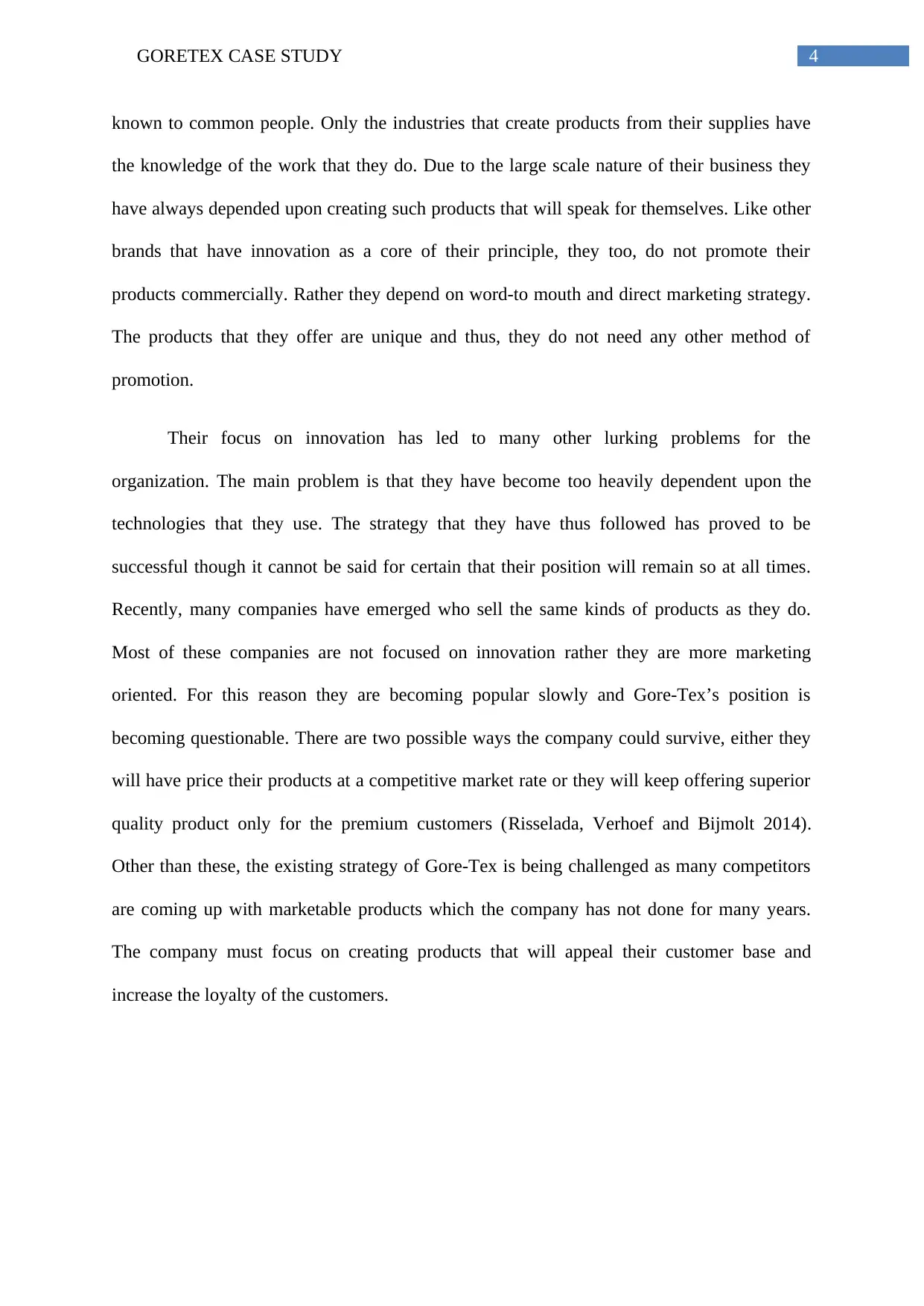
4GORETEX CASE STUDY
known to common people. Only the industries that create products from their supplies have
the knowledge of the work that they do. Due to the large scale nature of their business they
have always depended upon creating such products that will speak for themselves. Like other
brands that have innovation as a core of their principle, they too, do not promote their
products commercially. Rather they depend on word-to mouth and direct marketing strategy.
The products that they offer are unique and thus, they do not need any other method of
promotion.
Their focus on innovation has led to many other lurking problems for the
organization. The main problem is that they have become too heavily dependent upon the
technologies that they use. The strategy that they have thus followed has proved to be
successful though it cannot be said for certain that their position will remain so at all times.
Recently, many companies have emerged who sell the same kinds of products as they do.
Most of these companies are not focused on innovation rather they are more marketing
oriented. For this reason they are becoming popular slowly and Gore-Tex’s position is
becoming questionable. There are two possible ways the company could survive, either they
will have price their products at a competitive market rate or they will keep offering superior
quality product only for the premium customers (Risselada, Verhoef and Bijmolt 2014).
Other than these, the existing strategy of Gore-Tex is being challenged as many competitors
are coming up with marketable products which the company has not done for many years.
The company must focus on creating products that will appeal their customer base and
increase the loyalty of the customers.
known to common people. Only the industries that create products from their supplies have
the knowledge of the work that they do. Due to the large scale nature of their business they
have always depended upon creating such products that will speak for themselves. Like other
brands that have innovation as a core of their principle, they too, do not promote their
products commercially. Rather they depend on word-to mouth and direct marketing strategy.
The products that they offer are unique and thus, they do not need any other method of
promotion.
Their focus on innovation has led to many other lurking problems for the
organization. The main problem is that they have become too heavily dependent upon the
technologies that they use. The strategy that they have thus followed has proved to be
successful though it cannot be said for certain that their position will remain so at all times.
Recently, many companies have emerged who sell the same kinds of products as they do.
Most of these companies are not focused on innovation rather they are more marketing
oriented. For this reason they are becoming popular slowly and Gore-Tex’s position is
becoming questionable. There are two possible ways the company could survive, either they
will have price their products at a competitive market rate or they will keep offering superior
quality product only for the premium customers (Risselada, Verhoef and Bijmolt 2014).
Other than these, the existing strategy of Gore-Tex is being challenged as many competitors
are coming up with marketable products which the company has not done for many years.
The company must focus on creating products that will appeal their customer base and
increase the loyalty of the customers.
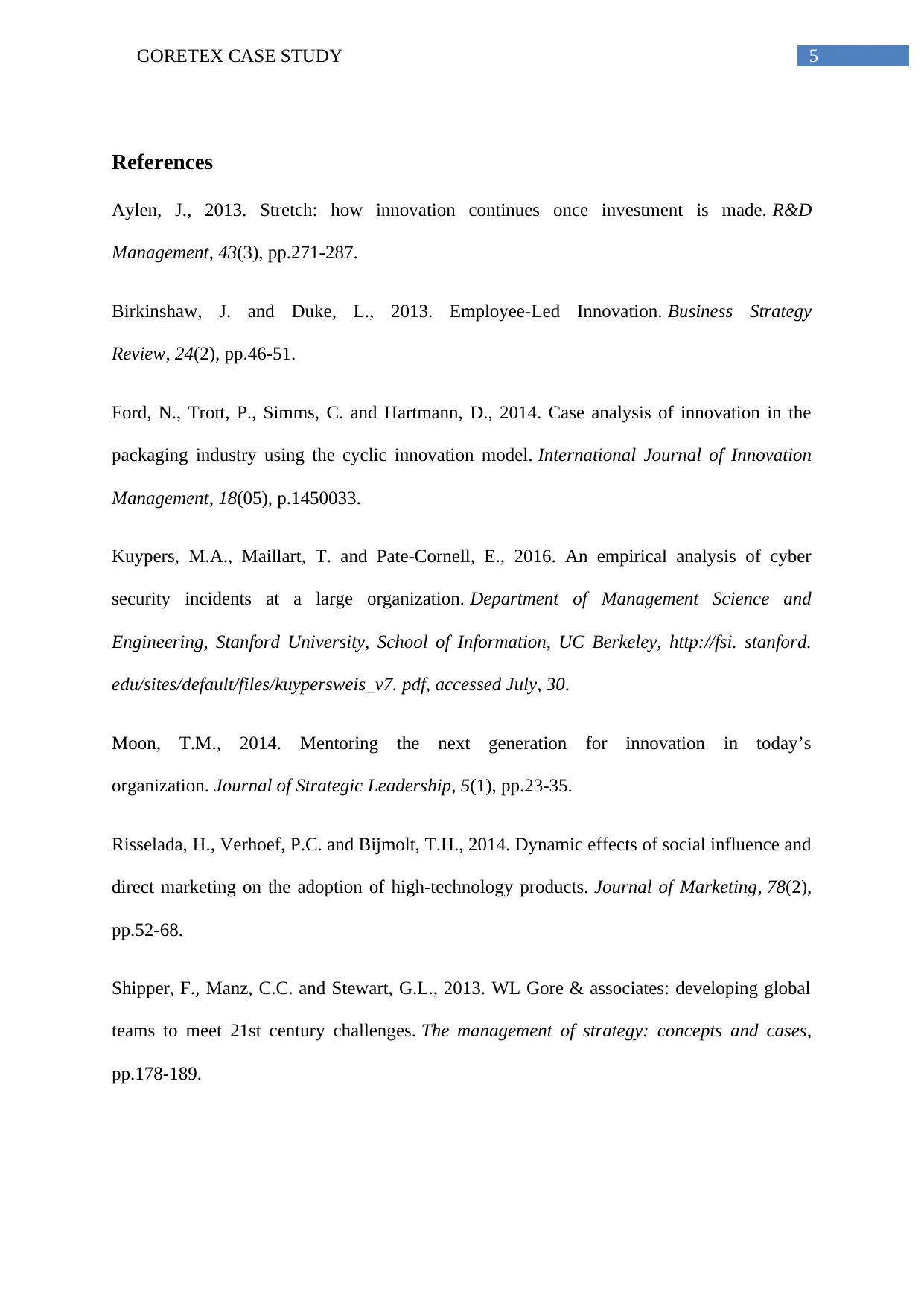
5GORETEX CASE STUDY
References
Aylen, J., 2013. Stretch: how innovation continues once investment is made. R&D
Management, 43(3), pp.271-287.
Birkinshaw, J. and Duke, L., 2013. Employee‐Led Innovation. Business Strategy
Review, 24(2), pp.46-51.
Ford, N., Trott, P., Simms, C. and Hartmann, D., 2014. Case analysis of innovation in the
packaging industry using the cyclic innovation model. International Journal of Innovation
Management, 18(05), p.1450033.
Kuypers, M.A., Maillart, T. and Pate-Cornell, E., 2016. An empirical analysis of cyber
security incidents at a large organization. Department of Management Science and
Engineering, Stanford University, School of Information, UC Berkeley, http://fsi. stanford.
edu/sites/default/files/kuypersweis_v7. pdf, accessed July, 30.
Moon, T.M., 2014. Mentoring the next generation for innovation in today’s
organization. Journal of Strategic Leadership, 5(1), pp.23-35.
Risselada, H., Verhoef, P.C. and Bijmolt, T.H., 2014. Dynamic effects of social influence and
direct marketing on the adoption of high-technology products. Journal of Marketing, 78(2),
pp.52-68.
Shipper, F., Manz, C.C. and Stewart, G.L., 2013. WL Gore & associates: developing global
teams to meet 21st century challenges. The management of strategy: concepts and cases,
pp.178-189.
References
Aylen, J., 2013. Stretch: how innovation continues once investment is made. R&D
Management, 43(3), pp.271-287.
Birkinshaw, J. and Duke, L., 2013. Employee‐Led Innovation. Business Strategy
Review, 24(2), pp.46-51.
Ford, N., Trott, P., Simms, C. and Hartmann, D., 2014. Case analysis of innovation in the
packaging industry using the cyclic innovation model. International Journal of Innovation
Management, 18(05), p.1450033.
Kuypers, M.A., Maillart, T. and Pate-Cornell, E., 2016. An empirical analysis of cyber
security incidents at a large organization. Department of Management Science and
Engineering, Stanford University, School of Information, UC Berkeley, http://fsi. stanford.
edu/sites/default/files/kuypersweis_v7. pdf, accessed July, 30.
Moon, T.M., 2014. Mentoring the next generation for innovation in today’s
organization. Journal of Strategic Leadership, 5(1), pp.23-35.
Risselada, H., Verhoef, P.C. and Bijmolt, T.H., 2014. Dynamic effects of social influence and
direct marketing on the adoption of high-technology products. Journal of Marketing, 78(2),
pp.52-68.
Shipper, F., Manz, C.C. and Stewart, G.L., 2013. WL Gore & associates: developing global
teams to meet 21st century challenges. The management of strategy: concepts and cases,
pp.178-189.
⊘ This is a preview!⊘
Do you want full access?
Subscribe today to unlock all pages.

Trusted by 1+ million students worldwide
1 out of 6
Related Documents
Your All-in-One AI-Powered Toolkit for Academic Success.
+13062052269
info@desklib.com
Available 24*7 on WhatsApp / Email
![[object Object]](/_next/static/media/star-bottom.7253800d.svg)
Unlock your academic potential
Copyright © 2020–2025 A2Z Services. All Rights Reserved. Developed and managed by ZUCOL.





